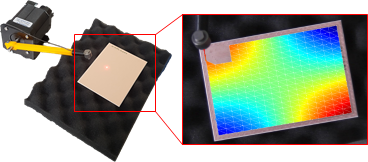Impact of substrate dynamics on the ultrasonic welding process
In addition to ultrasonic wire bonding, the process of ultrasonic welding plays an important role in power semiconductor electronics. In particular, the terminals connected to the substrate are welded utilizing this process. In comparison to ultrasonic wire bonding an increased amount of power is needed for a successful weld because of the increased size of the areas being connected. Still, the underlying mechanisms are very similar.
In order to achieve a good quality weld a sufficient amount of relative motion between substrate and terminal is required. This relative motion can be decreased by substrate vibrations, which is why a detailed study of substrate dynamics during the welding process is necessary. Furthermore, these investigations could help with identifying possible damages of sensitive components such as wire bonds or semiconductors caused by resonance effects. In typical production environments complex bearings for the power module are designed to control substrate dynamics. By modeling the dynamic behavior, this design process can be improved and accelerated. As a basis for this, experimental vibration analyses by laser vibrometry are utilized. In the field of ultrasonic welding LDM is cooperating closely with Infineon Technologies AG Warstein, a manufacturer of power semiconductor modules.
Publications regarding this field of study can be found here.



